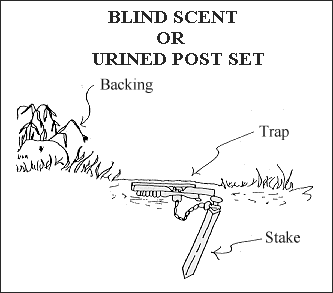

DISTRIBUTION: Statewide. Most abundant in the southwestern part of the state and in the counties just east of the Missouri River. Also abundant in the Turtle Mountains and Pembina Hills. Occasional throughout the rest of North Dakota, least abundant in the southeastern part of the state.
HABITAT: The coyote is very adaptable and its wide range in North Dakota is proof of its ability to exist even in well settled areas. Coyotes are most commonly found in rough, timbered areas such as the badlands and Turtle Mountains.
LIFE HISTORY: Coyotes breed in late January or early February. The four to nine pups are born 63 days later in late March or early April. The average litter has from five to seven pups. The young coyotes remain in the den for three to four weeks. The den is usually located in dense brush, often on a hillside and is often an enlarged badger den. When the young coyotes are old enough to get around, they accompany their parents and learn how to hunt. They stay with their parents until fall or early winter when the family group splits up.
Coyotes breed when they are a year old whereas their larger relatives, the wolves, do not breed until they are two years old.
Coyotes are most active at night although they are commonly seen out during the daytime as well. They do not hibernate but are very active during the winter months.
Coyotes weigh from eighteen to forty pounds with occasional larger specimens weighing as high as forty-five pounds. The coyotes of western North Dakota are usually somewhat smaller and lighter colored than those of the Turtle Mountains and northeastern North Dakota and are classified as a distinct subspecies. The larger, darker colored coyote is often called "brush wolf, but it is not a true wolf.
FOOD HABITS: Rabbits, ground squirrels, mice and other rodents provide the bulk of the coyotes' diet. Coyotes also eat carrion, birds, poultry, and almost any available flesh. They occasionally kill lambs, sheep, young livestock, deer and antelope. Like the red fox, they are opportunists and will kill whatever is easiest to come by. When rabbits and rodents are abundant, they provide almost the entire diet for coyotes. The coyote can be very destructive, especially around poultry and sheep ranches.
Coyotes are close relatives of the dog; in fact, they will mate with dogs. They establish definite routes of travel and will follow them as they make their rounds in an area. If you can locate these travel routes, you can catch coyotes. Trail sets such as explained for trapping foxes work well for coyotes once you have determined their lanes of travel.
Scent post sets are the most commonly used and the most effective coyote sets. If you can locate a spot that has been used as an urinating spot, it is better than making an artificial scent post. Coyotes will urinate at the same spots every time they are in an area but may miss a post that you have created even if you have soaked it in urine.

Scent post sets such as this can be established in areas where coyotes run. Use coyote urine in place of fox urine. Coyotes often leave scratch marks around urinating posts just as a dog does. Some trappers make scratches around their scent post sets to make them appear more natural and to stimulate the intended quarry.